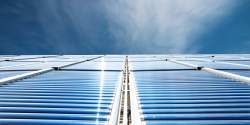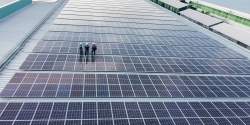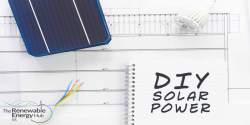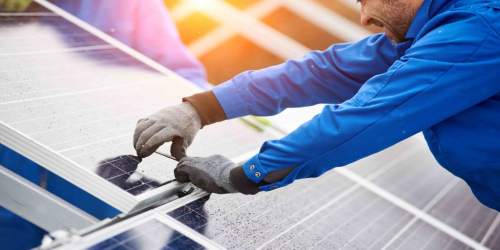Read Time : 4 Minutes
What are solar cells made up of
A frequently asked question is what solar cells are actually made of, and how they are made. After all, solar panels themselves are made up of multiple solar cells, all of which work to absorb the sunlight and convert it into electricity. This page takes you through what solar cells are, how they are made, and the different materials that they can be made up of.
What Are Solar Cells?
Solar cells are also known as photovoltaic cells (PV), which work to generate electricity directly from sunlight. This is different to photovoltaic thermal cells (PVT), which work to provide heat for water in the home. Photovoltaic cells are connected electrically, and neatly organised into a large frame that is known as a solar panel. The actual solar cells are made of silicon semiconductors that absorb sunlight and then convert it into electricity.
Currently, solar panels that are used for domestic purposes are only able to take around 20% of the sunlight that they receive and turn it into electricity. This is what is known as solar efficiency. There are several other forms of solar cell available that are used for commercial and industrial purposes. These are able to have an efficiency rating of up to 40%, but they do tend to be more expensive than domestic models.
One of the great things about solar technology is the fact that advances in the field are constantly being made, raising the overall quality and efficiency. It is expected that this will only increase with further research and development. Similarly, as these aspects increase, the price of solar panels is expected to keep falling – making them available to a much wider number of people.
COMPARE PRICES FROM LOCAL INSTALLERS
Compare prices from local companies fast & free
Enter your postcode to compare quotes from leading professionals. We promise to keep your information Safe & Secure. Privacy Policy
How Solar Cells Are Made
Stage One: Purifying the silicon The silicon dioxide is placed into an electric arc furnace. Next, a carbon arc is applied in order to release the oxygen. The resulting products are carbon dioxide and molten silicon. This will yield silicon that only has 1% impurity, which is useful in a number of industries. However, it is not yet pure enough for solar cells. The silicon, currently at 99% purity, is not purified even further using something called the floating zone technique. A rod of impure silicon is passed through a heated zone several times in the same direction. What the procedure does is drag the impurities towards one end with each pass. At a certain point, the silicon will be deemed pure, and the impure end will be removed.
Stage Two: Making single crystal silicon Solar cells are made from silicon boules. These are polycrystalline structures that have the atomic structure of a single crystal. The most commonly used method for the creation of the boule is known as the Czochralski method. During this process, a seed crystal of silicon is dipped into melted polycrystalline silicon. As the seed crystal is withdrawn, it is rotated, which means a cylindrical ingot, which is the boule, of silicon, is formed. The ingot is completely pure, as all impurities are left in the liquid.
Stage Three: Making silicon wafers Silicon wafers from the boule are sliced individually using a circular saw, the inner diameter of which cuts into the rod. A diamond saw is best for slicing, producing a cut that is as wide as the wafer. Around one-half of the silicon is lost from the boule to the finished circular wafer, although more can be lost is the wafer is cut into a rectangular or hexagonal shape. These shapes are sometimes used in solar cells because they can be fitted together perfectly, utilising all of the available space on the surface of the solar cell. Next, the wafers are polished to remove any saw marks, although some manufacturers have chosen to leave these marks as it has been found that rougher cells may absorb light more effectively.
Stage Four: Doping The most recent form of doping (also known as adding impurities to the silicon wafers) silicon with phosphorous is using a small particle accelerator to ‘shoot’ the phosphorous ions into the ingot. By controlling the speed of the ions, it becomes possible to control the depth of penetration. However, this new process has not yet been fully accepted. The traditional method tends to involve the introduction of a small amount of boron during the previous stage.
Stage Five: Placing electrical contacts Electrical contacts are used to connect each solar cell to the other, as well as to the receiver of the produced current. The contact needs to be incredibly thin so that they do not block any sunlight from being harnessed by the cell. Metals like palladium or copper are vacuum evaporated through a photoresist or deposited on the exposed portion of cells that have been partially covered with wax. After the contacts have been put in place, thin strips are placed between the cells. The most commonly used strips are tin-coated copper.
Stage Six: The anti-reflective coating Pure silicon is naturally shiny, allowing it to reflect up to 35 percent of the sunlight that hits it. In order to reduce the amount of sunlight that is lost, an anti-reflective coating is put onto the silicon wafer. The most commonly used types of coating are titanium dioxide and silicon oxide. The material that is used for the coating is either heated until its molecules boil off and travel to the silicon in order to condense, or the material undergoes sputtering. During this process, a high voltage will knock molecules off the material and deposit them onto the silicon and then deposit them onto the silicon at the opposite electrode.
Stage Seven: Encapsulating the cell The now finished solar cells are encapsulated. This means that they are sealed into silicon rubber or ethylene vinyl acetate. The encapsulated solar cells are then placed into an aluminium frame that has a Mylar or Tedlar back-sheet and a glass or plastic cover.
The Materials Found in Solar Cells
Here are the main materials that make up the solar cells in each panel. Monocrystalline cells Monocrystalline solar cells are made from single crystalline silicon. They have an incredibly distinctive appearance, as they are often coloured. The cells themselves also tend to have quite a cylindrical shape. So that they can keep the costs low and the performance at optimal levels, manufacturers tend to cut out the four sides of the monocrystalline cells.
While this gives them their recognisable appearance, it is also quite a wasteful process. They tend to have the highest levels of efficiency and are considered the highest quality of the three main types of material. Polycrystalline Solar Cells Polycrystalline solar panels were first introduced to the public in 1981.
Unlike their monocrystalline counterparts, polycrystalline cells do not require each of the four sides to be cut – which results in less waste. Instead of cutting, the silicon is melted and poured into square moulds. These then result in perfectly shaped square cells. The polycrystalline solar panel is considered to be the mid-range panels in terms of price and efficiency out of the three main materials used. Thin Film Solar Cells Thin film solar cells are manufactured by placing several thin layers of photovoltaic on top of each other to creates the module.
There are actually a few different types of thin film solar cell, and the way in which they differ from each other comes down to the material used for the PV layers. The types are as follows:
- Amorphous silicon
- Cadmium telluride
- Copper indium gallium selenide
- Organic PV cells
Thin film solar cells are considered to be the cheapest option when it comes to solar panels, but they are also the least efficient. However, thin film solar cells also have the most potential for the future.
Want to Know More?
Have you found yourself interested in solar panels? If you're ready to move forward, head over to our directory of approved installation companies to find an approved installer in your area. Or simply give us a ring using the number at the top of this page and have a chat.
Find a local installer
Welcome to the biggest directory of UK renewable energy companies





 How Much do Solar Panel Systems Cost in 2024?
How Much do Solar Panel Systems Cost in 2024?







